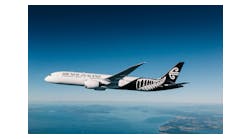NEW YORK, January 16, 2014 ? PwC US today released Aviation Perspectives: The Impact of Mega-Mergers, A New Foundation for the US Airline Industry, a report that reveals how merger-driven consolidation will continue to have a significant and positive effect on the domestic airline industry. The report, which also highlights the expansion of low cost carriers (LCCs) into major domestic routes and the improvement of airline operations and customer experience, is an updated analysis of PwC’s original Aviation Perspectives, which found that the average U.S. domestic airfares had not increased significantly due to consolidation.
“Average increases in U.S. domestic airfares continue to lag behind major cost drivers, as fare increases since 2004 have been quite modest, rising at approximately two percent on an annual basis, and actually decreasing when adjusted for inflation,” said Jonathan Kletzel, U.S. transportation and logistics leader, PwC. “The fourth and likely last airline mega-merger in the U.S. was recently approved, and while this certainly is a historic level of consolidation, there remain other sizeable airlines serving the U.S. domestic market, pushing companies to look for new ways to remain competitive.”
Low Cost Carriers and Airfares
According to the report, a primary reason for the moderate growth in airfares over the past few years has been the expansion of LCCs into many major domestic routes. As part of the most recent mega-merger, LCCs are likely to benefit from the divestiture of nearly 170 take-off and landing slots and the transfer of 10 gates in key markets such as New York, Washington, D.C., Boston, Dallas, Miami and Chicago. The report also found that LCCs have been expanding faster than traditional carriers. In North America, LCC passenger traffic grew by 15 percent between 2008 and 2013, and is now 30 percent of domestic traffic. With LCCs and competition continuing to moderate average airfare increases, airlines are turning to other sources of revenue such as ancillary fees for new sources of revenue.
Consolidation Improves Operating Performance
As airlines have merged, overall efficiency in operations have improved, as carriers removed capacity from the system and streamlined their networks, resulting in fewer takeoffs and landings, says PwC. Between 2008 and 2013, the number of domestic flights decreased more than the number of domestic passengers, as evidenced by increasing load factors. This reduced flying has created a better balance between runway and airspace supply and demand, reducing congestion delays and allowing airlines to recover from disruptions more quickly. Key metrics that demonstrate improvement of passenger experience include:
On-time performance: According to the report, U.S. flights experienced a 17 percent decrease in arrival delays and an eight percent decrease in departure delays between 2008 and 2013 – a key indicator of operational efficiency. The 20 busiest U.S. airports saw a 21 percent decrease in delays for arrivals and a 10 percent decrease for departures.
Flight cancellations: Passengers experienced a 26 percent decrease in flight cancellations between 2008 and 2013, significantly decreasing the number of passengers who require flight re-accommodation.
Baggage handling: Carriers reported a 31 percent improvement in baggage handling, with reports of mishandled bags dropping from 4.6 incidents per 1,000 passengers in Q3 2008 to 3.2 reported incidents in Q3 of 2013.
What’s next for the industry?
With airline consolidation reshaping the industry, PwC identifies four key trends that will likely define the industry in the near-term:
Sustained profitability: Domestic airlines have been profitable since 2010, and analysts expect 2013 to be profitable as well. Network carriers have been able to exert capacity discipline, eliminating redundant or unprofitable routes and rescheduling flights to better align with customer demand. In addition, as carriers replace their aging fleets, they’ll see additional gains from newer, more fuel-efficient planes.
Business model convergence: LCCs are contending with aging aircraft that are driving maintenance costs higher and a maturing workforce that increases labor cost pressure. As LCCs have increased prices to cover increasing costs, their fares are more closely matching those of the network carriers. According to the report, stable LCC markets experienced a 19 percent increase from 2008 to 2013, over twice the nine percent increase in non-LCC markets. Now that mega-mergers have changed the competitive landscape, the business models of these remaining airlines are converging.
Ultra LCCs and mainline unbundling: Ultra LCCs are rapidly growing. As LCC airfares continue to rise, ultra LCC airlines distinguish themselves by charging the lowest base fare and collecting the highest ancillary fees. Ultra LCC traffic has almost doubled from 2008 to 2013, according to PwC, and if this business model continues to prove successful, it will likely incentivize some carriers to unbundle their product and services mix, at least for certain passenger segments.
Improvements to product quality: More carriers are competing for customers based on product and service offerings, as passengers continue to search for and book flights based on best price, reliability, convenience and amenities. As a result, airlines are increasing investments in customer experience improvements such as in-flight Wi-Fi, premium seating options, and operational reliability infrastructure.
“Carriers today are able to make more investments in improving their operations, as merger-driven consolidation has had a positive impact on the financial stability of the domestic airline industry,” continued Kletzel. “Customer experience will remain a priority for airlines, as companies continue to upgrade their operations and improve efficiency in this time of relative financial stability.”
For a copy of PwC’s Aviation Perspectives: The Impact of Mega-Mergers: A New Foundation for the US Airline Industry, please visit: www.pwc.com/us/aviationperspectives.




